Investigations on porous silicon nitride ceramics prepared by the gel-casting method
IF 0.7
4区 材料科学
Q4 METALLURGY & METALLURGICAL ENGINEERING
引用次数: 0
Abstract
Due to their special structure and many excellent properties, porous Si3N4 ceramics have a wide range of potential applications as a new structural and functional integrated material. In the present study, porous Si3N4 ceramics with excellent bending properties and satisfactory porosity were prepared by the gel-casting method. The variations in porosity, bending strength, fracture morphology and phase composition of the porous Si3N4 ceramics with different weight fractions of La2O3–MgO sintering additive were investigated. The results showed that the density of porous Si3N4 ceramics increased linearly with the increase of sintering additive content. When the content of sintering additive increased from 2.5 wt.% to 10 wt.%, the porosity of porous ceramics decreased from 30 % to 10 %. With the increase of sintering additive content, the bending strength of the samples first increased and then decreased. When the sintering additive content was 5.0 wt.%, the average bending strength of the samples reached a maximum of 240.88 MPa, and scanning electron microscopy and X-ray diffractometry results showed that β-Si3N4 particles with well-developed pores and a maximum aspect ratio of 5.8 were formed in the porous silicon nitride ceramics. This study provides a reference for the preparation of porous Si3N4 ceramics with good bending properties and porosity.对凝胶铸造法制备的多孔氮化硅陶瓷的研究
多孔 Si3N4 陶瓷具有特殊的结构和许多优异的性能,因此作为一种新型结构和功能集成材料具有广泛的应用潜力。本研究采用凝胶铸造法制备了弯曲性能优异、孔隙率令人满意的多孔 Si3N4 陶瓷。研究了不同重量分数的 La2O3-MgO 烧结添加剂对多孔 Si3N4 陶瓷的孔隙率、弯曲强度、断口形貌和相组成的影响。结果表明,多孔 Si3N4 陶瓷的密度随烧结添加剂含量的增加而线性增加。当烧结添加剂的含量从 2.5 wt.% 增加到 10 wt.% 时,多孔陶瓷的孔隙率从 30 % 下降到 10 %。随着烧结添加剂含量的增加,样品的抗弯强度先上升后下降。当烧结添加剂含量为 5.0 wt.%时,样品的平均弯曲强度达到 240.88 MPa 的最大值,扫描电子显微镜和 X 射线衍射测量结果表明,多孔氮化硅陶瓷中形成了孔隙发达、最大长宽比为 5.8 的 β-Si3N4 颗粒。这项研究为制备具有良好弯曲性能和孔隙率的多孔 Si3N4 陶瓷提供了参考。
本文章由计算机程序翻译,如有差异,请以英文原文为准。
求助全文
约1分钟内获得全文
求助全文
来源期刊
CiteScore
1.30
自引率
12.50%
发文量
119
审稿时长
6.4 months
期刊介绍:
The International Journal of Materials Research (IJMR) publishes original high quality experimental and theoretical papers and reviews on basic and applied research in the field of materials science and engineering, with focus on synthesis, processing, constitution, and properties of all classes of materials. Particular emphasis is placed on microstructural design, phase relations, computational thermodynamics, and kinetics at the nano to macro scale. Contributions may also focus on progress in advanced characterization techniques. All articles are subject to thorough, independent peer review.

 求助内容:
求助内容: 应助结果提醒方式:
应助结果提醒方式:


